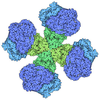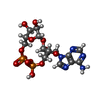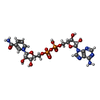+ Open data
Open data
- Basic information
Basic information
| Entry | Database: PDB / ID: 8bto | ||||||
|---|---|---|---|---|---|---|---|
| Title | Helical structure of BcThsA in complex with 1''-3'gcADPR | ||||||
 Components Components | NAD(+) hydrolase ThsA | ||||||
 Keywords Keywords |  HYDROLASE / Thoeris / HYDROLASE / Thoeris /  SIR2 domain / SIR2 domain /  SLOG domain / 3'cADPR SLOG domain / 3'cADPR | ||||||
| Function / homology |  Function and homology information Function and homology information NAD+ glycohydrolase / defense response to virus / NAD+ glycohydrolase / defense response to virus /  hydrolase activity / hydrolase activity /  nucleotide binding / nucleotide binding /  cytoplasm cytoplasmSimilarity search - Function | ||||||
| Biological species |   Bacillus cereus MSX-D12 (bacteria) Bacillus cereus MSX-D12 (bacteria) | ||||||
| Method |  ELECTRON MICROSCOPY / helical reconstruction / ELECTRON MICROSCOPY / helical reconstruction /  cryo EM / Resolution: 2.96 Å cryo EM / Resolution: 2.96 Å | ||||||
 Authors Authors | Tamulaitiene, G. / Sasnauskas, G. / Sabonis, D. | ||||||
| Funding support | Lithuania, 1items
| ||||||
 Citation Citation |  Journal: Nature / Year: 2024 Journal: Nature / Year: 2024Title: Activation of Thoeris antiviral system via SIR2 effector filament assembly. Authors: Giedre Tamulaitiene / Dziugas Sabonis / Giedrius Sasnauskas / Audrone Ruksenaite / Arunas Silanskas / Carmel Avraham / Gal Ofir / Rotem Sorek / Mindaugas Zaremba / Virginijus Siksnys /   Abstract: To survive bacteriophage (phage) infections, bacteria developed numerous anti-phage defence systems. Some of them (for example, type III CRISPR-Cas, CBASS, Pycsar and Thoeris) consist of two modules: ...To survive bacteriophage (phage) infections, bacteria developed numerous anti-phage defence systems. Some of them (for example, type III CRISPR-Cas, CBASS, Pycsar and Thoeris) consist of two modules: a sensor responsible for infection recognition and an effector that stops viral replication by destroying key cellular components. In the Thoeris system, a Toll/interleukin-1 receptor (TIR)-domain protein, ThsB, acts as a sensor that synthesizes an isomer of cyclic ADP ribose, 1''-3' glycocyclic ADP ribose (gcADPR), which is bound in the Smf/DprA-LOG (SLOG) domain of the ThsA effector and activates the silent information regulator 2 (SIR2)-domain-mediated hydrolysis of a key cell metabolite, NAD (refs. ). Although the structure of ThsA has been solved, the ThsA activation mechanism remained incompletely understood. Here we show that 1''-3' gcADPR, synthesized in vitro by the dimeric ThsB' protein, binds to the ThsA SLOG domain, thereby activating ThsA by triggering helical filament assembly of ThsA tetramers. The cryogenic electron microscopy (cryo-EM) structure of activated ThsA revealed that filament assembly stabilizes the active conformation of the ThsA SIR2 domain, enabling rapid NAD depletion. Furthermore, we demonstrate that filament formation enables a switch-like response of ThsA to the 1''-3' gcADPR signal. | ||||||
| History |
|
- Structure visualization
Structure visualization
| Structure viewer | Molecule:  Molmil Molmil Jmol/JSmol Jmol/JSmol |
|---|
- Downloads & links
Downloads & links
- Download
Download
| PDBx/mmCIF format |  8bto.cif.gz 8bto.cif.gz | 980.5 KB | Display |  PDBx/mmCIF format PDBx/mmCIF format |
|---|---|---|---|---|
| PDB format |  pdb8bto.ent.gz pdb8bto.ent.gz | 818.9 KB | Display |  PDB format PDB format |
| PDBx/mmJSON format |  8bto.json.gz 8bto.json.gz | Tree view |  PDBx/mmJSON format PDBx/mmJSON format | |
| Others |  Other downloads Other downloads |
-Validation report
| Arichive directory |  https://data.pdbj.org/pub/pdb/validation_reports/bt/8bto https://data.pdbj.org/pub/pdb/validation_reports/bt/8bto ftp://data.pdbj.org/pub/pdb/validation_reports/bt/8bto ftp://data.pdbj.org/pub/pdb/validation_reports/bt/8bto | HTTPS FTP |
|---|
-Related structure data
| Related structure data |  16233MC  8btnC 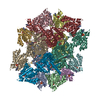 8btpC C: citing same article ( M: map data used to model this data |
|---|---|
| Similar structure data | Similarity search - Function & homology  F&H Search F&H Search |
- Links
Links
- Assembly
Assembly
| Deposited unit | 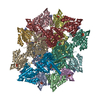
|
|---|---|
| 1 |
|
- Components
Components
| #1: Protein | Mass: 55417.746 Da / Num. of mol.: 12 / Mutation: N112A Source method: isolated from a genetically manipulated source Source: (gene. exp.)   Bacillus cereus MSX-D12 (bacteria) / Gene: thsA, II9_05448 / Production host: Bacillus cereus MSX-D12 (bacteria) / Gene: thsA, II9_05448 / Production host:   Escherichia coli BL21(DE3) (bacteria) / References: UniProt: J8G6Z1, Escherichia coli BL21(DE3) (bacteria) / References: UniProt: J8G6Z1,  NAD+ glycohydrolase NAD+ glycohydrolase#2: Chemical | ChemComp-OJC / ( #3: Chemical | ChemComp-NAD /  Nicotinamide adenine dinucleotide Nicotinamide adenine dinucleotideHas ligand of interest | Y | |
|---|
-Experimental details
-Experiment
| Experiment | Method:  ELECTRON MICROSCOPY ELECTRON MICROSCOPY |
|---|---|
| EM experiment | Aggregation state: HELICAL ARRAY / 3D reconstruction method: helical reconstruction |
- Sample preparation
Sample preparation
| Component | Name: BcThsA in complex with 1''-3'gcADPR / Type: COMPLEX / Entity ID: #1 / Source: RECOMBINANT | ||||||||||||||||
|---|---|---|---|---|---|---|---|---|---|---|---|---|---|---|---|---|---|
| Molecular weight | Experimental value: NO | ||||||||||||||||
| Source (natural) | Organism:   Bacillus cereus (bacteria) Bacillus cereus (bacteria) | ||||||||||||||||
| Source (recombinant) | Organism:   Escherichia coli (E. coli) Escherichia coli (E. coli) | ||||||||||||||||
| Buffer solution | pH: 7.5 | ||||||||||||||||
| Buffer component |
| ||||||||||||||||
| Specimen | Conc.: 1 mg/ml / Embedding applied: NO / Shadowing applied: NO / Staining applied : NO / Vitrification applied : NO / Vitrification applied : YES : YES | ||||||||||||||||
| Specimen support | Grid material: COPPER / Grid mesh size: 300 divisions/in. / Grid type: Quantifoil R1.2/1.3 | ||||||||||||||||
Vitrification | Instrument: FEI VITROBOT MARK IV / Cryogen name: ETHANE / Humidity: 95 % / Chamber temperature: 277 K |
- Electron microscopy imaging
Electron microscopy imaging
| Microscopy | Model: TFS GLACIOS |
|---|---|
| Electron gun | Electron source : :  FIELD EMISSION GUN / Accelerating voltage: 200 kV / Illumination mode: OTHER FIELD EMISSION GUN / Accelerating voltage: 200 kV / Illumination mode: OTHER |
| Electron lens | Mode: BRIGHT FIELD Bright-field microscopy / Nominal defocus max: 2000 nm / Nominal defocus min: 1000 nm Bright-field microscopy / Nominal defocus max: 2000 nm / Nominal defocus min: 1000 nm |
| Specimen holder | Cryogen: NITROGEN |
| Image recording | Average exposure time: 46.33 sec. / Electron dose: 30.64 e/Å2 / Detector mode: COUNTING / Film or detector model: FEI FALCON III (4k x 4k) / Num. of grids imaged: 1 / Num. of real images: 2321 |
- Processing
Processing
| Software |
| ||||||||||||||||||||||||
|---|---|---|---|---|---|---|---|---|---|---|---|---|---|---|---|---|---|---|---|---|---|---|---|---|---|
| EM software |
| ||||||||||||||||||||||||
CTF correction | Type: NONE | ||||||||||||||||||||||||
| Helical symmerty | Angular rotation/subunit: 128.947 ° / Axial rise/subunit: 41.87 Å / Axial symmetry: D2 | ||||||||||||||||||||||||
3D reconstruction | Resolution: 2.96 Å / Resolution method: FSC 0.143 CUT-OFF / Num. of particles: 233008 / Symmetry type: HELICAL | ||||||||||||||||||||||||
| Atomic model building | Protocol: FLEXIBLE FIT / Space: REAL | ||||||||||||||||||||||||
| Refinement | Cross valid method: NONE Stereochemistry target values: GeoStd + Monomer Library + CDL v1.2 | ||||||||||||||||||||||||
| Displacement parameters | Biso mean: 56.29 Å2 | ||||||||||||||||||||||||
| Refine LS restraints |
|
 Movie
Movie Controller
Controller




 PDBj
PDBj
